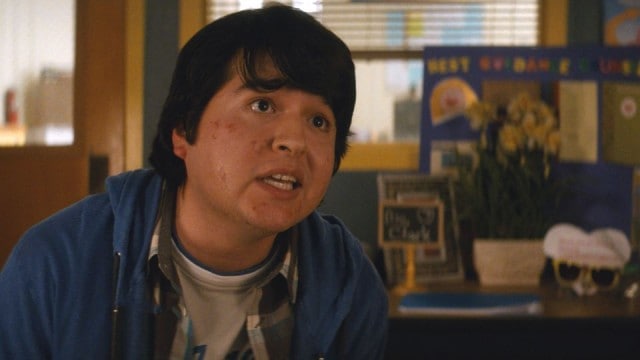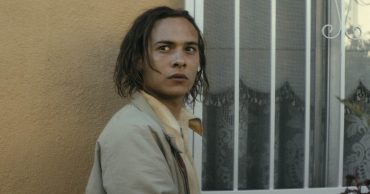
There are many ways Fear the Walking Dead overtly posits itself as a “different” zombie show in its first two episodes – the pilot by basically not being a zombie show, rather an hour-long narrative about a family being torn apart by their drug addict son. “So Close, Yet So Far” strays much closer to familiar territory for fans of the Walking Dead franchise, accelerating the onset of the apocalypse in Los Angeles, and proving there is an important tonal difference between the two shows, and how they deliver their individual brands of thriller.
The Walking Dead is a show that lives on dread; the dread of the unknown, the slow, creeping fright of a cornfield full of unseen, but heard zombies, or the assumption that every new human being Rick and his gang pass across is probably a murderer of some kind. Fear the Walking Dead, however, operates on a much more immediate level, trading in the creeping dread of the original for something more aligned with anxiety and panic. The heavy amount of handheld camera used in “So Close, Yet So Far” is an important instrument in creating this specific brand of tension: since we already know what’s going to happen around the Clark/Salazar family (as well as know what will happen to them, emotionally and psychologically), Fear the Walking Dead can draw on the known and unseen to generate said panic in any scene.
Focused slightly more on the fracturing of society than the near-fracturing of a family due to heroin, “So Close, Yet So Far” pulls its lens back a bit from the nuclear family of the show to examine what’s happening as the virus grips Los Angeles, and Madison and her husband scramble to protect their families. Cops are shooting unarmed people (zombies, but still unarmed people to the general public’s knowledge) while schools close and modern technology begins to fall apart. There aren’t really any surprises or unexpected left turns in FtWD‘s depiction of civilization’s end – unless you count a pimple-faced kid babbling about the apocalypse who returns to his empty high school for a small kitchen knife as “unexpected”, then “So Close, Yet So Far” might be able to throw you for a whirl.
It’s not until Madison is exiting the school with Tobias that Fear the Walking Dead finally begins to extrapolate on its characters: she takes down her first zombie in the form of Artie, who spent one too many days in an empty school without a good weapon, and nearly takes out Tobias the Nerd Seer, whose flailing arms and weak kitchen knife use really help give some ‘umph’ to his “I’ll be fine” statement when Madison drops him off at his house later on. Once Madison starts swinging that fire extinguisher, “So Close” appears to be finally gathering its rhythm, offering us a very, very small glimpse in Madison’s checkered past, the show’s first measurable moment of identity, painting its characters as something beyond the archetypal ‘modern, mostly divorced family’ depicted in the pilot.
Whenever “So Close” leaves Madison’s side, Fear suffers. Trapping Travis, Christopher, and Liza in a locked barber shop while LA riots is evocative for a moment (in how it repeats early The Walking Dead episodes, trapping its characters in a small space), but it doesn’t give the story a lot of room to grow beyond the cliches of “divorced, angsty teen” and “fiery ex-wife”. The freedom to move around Los Angeles allows for “So Close” to explore the other characters of the show in more engaging ways: Madison’s glimpse of darkness, Nick’s manipulative ways never ceasing (he tells Madison he “stopped” his sister from leaving; he really just had a massive seizure), and Alicia’s inability to stop being a dumb teenager and realize the world was ending (hey, I’m not saying they are ingeniously-crafted characters or anything) are all a lot more entertaining than some punk kid with a bunch of expensive electronics talking about how he’s “part of something” while filming a cop (probably posting it to Instagram with hashtags like #revolutionishappening or something pretentious), and the thoroughly cliche “working Hispanic” family they end up hanging out with.
The biggest issue with Fear the Walking Dead through two episodes are not its trouble with creating truly unique characters, or its ability to generate panic and not do a whole lot with it. The biggest problem right now is how falsely the show posits itself as progressive. The pilot offers an interracial teenage couple (the 1975 equivalent of “wow, how edgy!”) and a mixed-race, not married (*gasp*) family trying to navigate the apocalypse, but, like its predecessor, that assumption of racial equality is not met by the script. Three named characters have died so far between the principal, Nick’s drug dealer, and Alicia’s boyfriend – who are all black, and all dead by the end of the episode. The Walking Dead is infamously known for its black actor revolving door, consistently introducing and killing off minority characters, something that’s been a problem since T-Dog (the most useless character in the history of zombie cinema), and remains so to this day (Bob and Tyreese, rest in peace). The writers and showrunners can justify it as saying it’s how these parts “were written”, but it still doesn’t make the issue any less apparent on this show than the last – and when Fear the Walking Dead wants to have a protest scene vaguely alluding on the #AllLivesMatter hashtag, it feels like a classic case of having cake, and eating it too (or murdering a cake, then yelling at everyone for killing pastries).
“So Close, Yet So Far”, while being a much stronger, more direct episode than the pilot, still hasn’t done a whole lot (beyond Kim Dickens’ performance) to establish itself as something different than the show whose shadow it lives in, and whose name it wears. As Los Angeles falls apart and the stories of the two shows become more aligned, the impetus is on Fear the Walking Dead to engage viewers in a different way than the 60 other hours of similarly-named zombie television has done – the first two episodes and the panic they bring to LA offers up potential to fill this need, but it remains unclear whether this show will be able to shed the various attributes and deficiencies we’ve seen with The Walking Dead for the last five years.
[Photo via AMC]
 Follow Us
Follow Us






Yes thank you for calling them out for killing off three black characters in just two episodes. So so messed up.